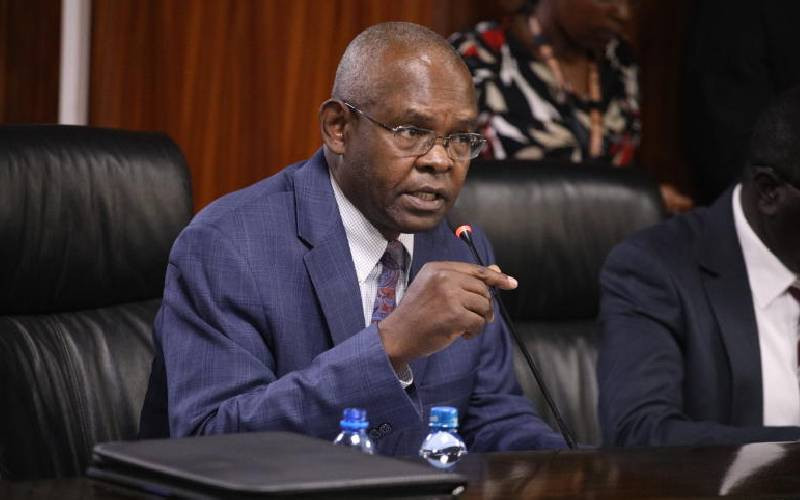The proposal by National Treasury Cabinet Secretary Henry Rotich for banks to increase their minimum core capital progressively for the next three years has opened a new opportunity for micro-finance institutions, investment clubs, Savings and Credit Co-operatives and other lenders to grow and increase their business volumes.
The picture looks rosier for those targeting the yet-to-be-explored, lower tier of the income pyramid.
Rotich proposed an increase in the minimum core capital requirement for banks, mortgage finance companies and insurance companies during the 2015-16 Budget speech to Parliament.
Banks are supposed to increase the minimum core capital progressively from the current Sh1 billion to Sh5 billion by December 2018.
Some experts say Savings and Credit Co-operative Societies (Saccos), which largely operate at the low end, are likely to get more operating space and entrench their presence and market share.
This will happen if banks increase the minimum savings deposits and minimum interest earning deposits to their clients. The Kenya Union of Savings and Credit Co-operatives (Kuscco), the umbrella organisation of Saccos in Kenya, says Saccos will continue to exploit their niche market.
The entity’s MD George Ototo says Saccos are likely to recruit more customers who might pull out from the banks as the latter institute new financial strategies.
“As the banks grow bigger and put in place new conditions, like increasing minimum saving deposits, customers who may be uncomfortable with the new scenario are likely shift to the credit unions. This way, Saccos will increase their numbers and grow their businesses, “ said Mr Ototo during an interview in his office.
customer numbers
He dismissed claims that the new requirements will frustrate ambitions of the Saccos hoping to transform into commercial banks.
Raising capital Ototo stated, will not be difficult because the State has provided a three-year window.
He said that Saccos, because of high customer numbers and loyalty, are well positioned to survive the new scenario and expand their capital base. The minimum capital base for Saccos currently stands at Sh10million. “The Saccos that have desires to venture into the banking industry will be forced to review their strategy in order to succeed,” said Ototo.
Sacco Societies Authority (Sasra) acting MD John Mwaka said that even though there is no immediate opportunity for Saccos, in the long run the credit unions will benefit if banks realign their businesses and make banking difficult for low-end clients.
“If banks grow big, possibilities are that they might graduate to high-end customers and ignore smaller clients. This could give the Saccos an opening to recruit more customers and grow their capital base as well as they expand more in the low end market,” said Mr Mwaka.
Some Saccos have in the recent past expressed interest to venture into the banking industry by either buying shareholding stake or transforming into full-banking units.
Stay informed. Subscribe to our newsletter
For example, Mwalimu Sacco bought a shareholding stake in Equatorial Bank while Unaitas, formerly Muramati, has been mobilising capital to enable it transform into a full-fledged bank by mid-2016.
The banking industry is also expected to witness a series of mergers, acquisitions and takeovers in the coming years. In the 2015-16 Budget, Treasury proposed to increase minimum capital for commercial banks from the current Sh1 billion to Sh5 billion by June 2018.
Finer details of how commercial banks will be required to proceed to increase capitalisation will be clearer once the 2015-16 Finance Bill is published and tabled before Parliament for debate.
“With regards to the proposed minimum capital levels, smaller banks, especially those with capital below Sh2 billion, there will be a need to consider mergers and acquisitions given the wide capital gap which they may be unable to close by 2018,” said Faith Waitherero Mwangi, an analyst at Standard Investment Bank (SIB).
“The other option is for smaller banks to retain profits, raise new capital from shareholders, acquire or merge with other banks. It is improbable that tier-one banks will acquire smaller banks,” said Ms Mwangi. The CBK banking supervision report 2014 indicates that the banking industry is dominated by six banks that command half the entire market.
 The Standard Group Plc is a
multi-media organization with investments in media platforms spanning newspaper
print operations, television, radio broadcasting, digital and online services. The
Standard Group is recognized as a leading multi-media house in Kenya with a key
influence in matters of national and international interest.
The Standard Group Plc is a
multi-media organization with investments in media platforms spanning newspaper
print operations, television, radio broadcasting, digital and online services. The
Standard Group is recognized as a leading multi-media house in Kenya with a key
influence in matters of national and international interest.
 The Standard Group Plc is a
multi-media organization with investments in media platforms spanning newspaper
print operations, television, radio broadcasting, digital and online services. The
Standard Group is recognized as a leading multi-media house in Kenya with a key
influence in matters of national and international interest.
The Standard Group Plc is a
multi-media organization with investments in media platforms spanning newspaper
print operations, television, radio broadcasting, digital and online services. The
Standard Group is recognized as a leading multi-media house in Kenya with a key
influence in matters of national and international interest.





